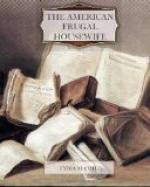There is another method of making yeast, which is much easier, and I think quite as good. Stir rye and cold water, till you make a stiff thickening. Then pour in boiling water, and stir it all the time, till you make it as thin as the yeast you buy; three or four table spoons heaping full are enough for a quart of water. When it gets about cold, put in half a pint of lively yeast. When it works well, bottle it; but if very lively, do not cork your bottle very tight, for fear it will burst. Always think to make new yeast before the old is gone; so that you may have some to work with. Always wash and scald your bottle clean after it has contained sour yeast. Beware of freezing yeast.
Milk yeast is made quicker than any other. A pint of new milk with a tea-spoonful of salt, and a large spoon of flour stirred in, set by the fire to keep lukewarm, will make yeast fit for use in an hour. Twice the quantity of common yeast is necessary, and unless used soon is good for nothing. Bread made of this yeast dries sooner. It is convenient in summer, when one wants to make biscuits suddenly.
A species of leaven may be made that will keep any length of time. Three ounces of hops in a pail of water boiled down to a quart; strain it, and stir in a quart of rye meal while boiling hot. Cool it, and add half a pint of good yeast; after it has risen a few hours, thicken it with Indian meal stiff enough to roll out upon a board; then put it in the sun and air a few days to dry. A piece of this cake two inches square, dissolved in warm water, and thickened with a little flour, will make a large loaf of bread.
Potatoes make very good yeast. Mash three large potatoes fine; pour a pint of boiling water over them; when almost cold, stir in two spoonfuls of flour, two of molasses, and a cup of good yeast. This yeast should be used while new.
* * * * *
PRESERVES, &C.
Economical people will seldom use preserves, except for sickness. They are unhealthy, expensive, and useless to those who are well. Barberries preserved in molasses are very good for common use. Boil the molasses, skim it, throw in the barberries, and simmer them till they are soft. If you wish to lay by a few for sickness, preserve them in sugar by the same rule as other preserves. Melt the sugar, skim it, throw in the barberries; when done soft, take them out, and throw in others.
A pound of sugar to a pound of fruit is the rule for all preserves. The sugar should be melted over a fire moderate enough not to scorch it. When melted, it should be skimmed clean, and the fruit dropped in to simmer till it is soft. Plums, and things of which the skin is liable to be broken, do better to be put in little jars, with their weight of sugar, and the jars set in a kettle of boiling water, till the fruit is done. See the water is not so high as to boil into the jars.




